Proper TV wall mount installation ensures a secure, level, and visually appealing setup. This guide covers safety, tools, and steps for a successful mounting process.
1.1 Importance of Proper Installation
Proper TV wall mount installation is crucial for safety, stability, and optimal viewing experience. It ensures the TV is securely fastened, preventing accidents and damage. Incorrect installation can lead to uneven placement, poor weight distribution, or even TV damage. Always follow manufacturer guidelines to guarantee a safe and professional setup. Proper mounting also enhances aesthetics and functionality, making it essential for both practicality and visual appeal in any room.
1.2 Safety Precautions and Warnings
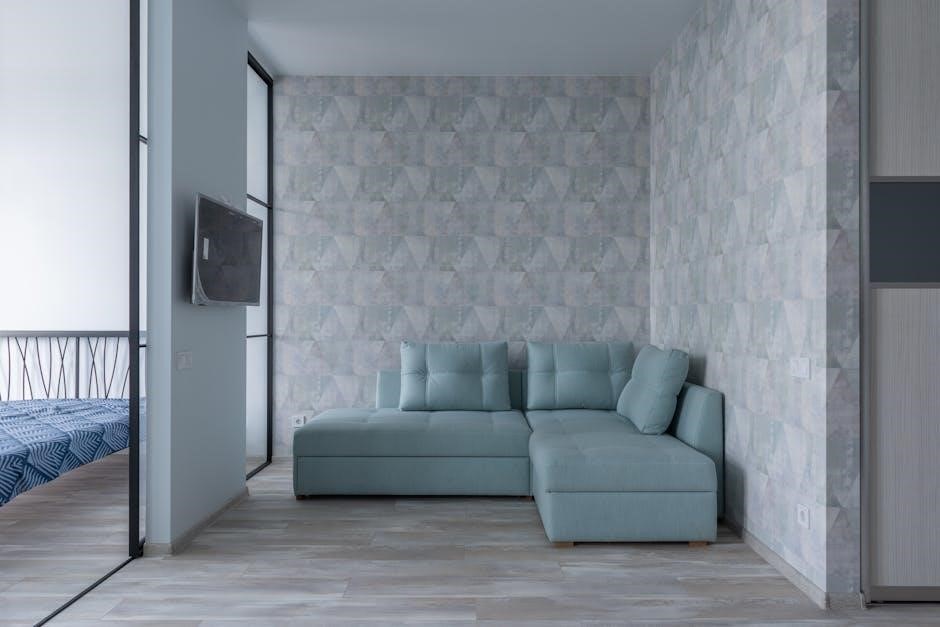
Ensure the TV is turned off before installation to prevent damage or electrical hazards. Avoid mounting on metal framing or unstable surfaces. Use appropriate hardware for wall type to prevent collapse. Do not exceed weight limits specified by the mount manufacturer. Always follow the installation manual instructions carefully. If unsure, consult a professional installer to avoid risks of injury or damage. Regular inspections are recommended to maintain stability and safety over time.
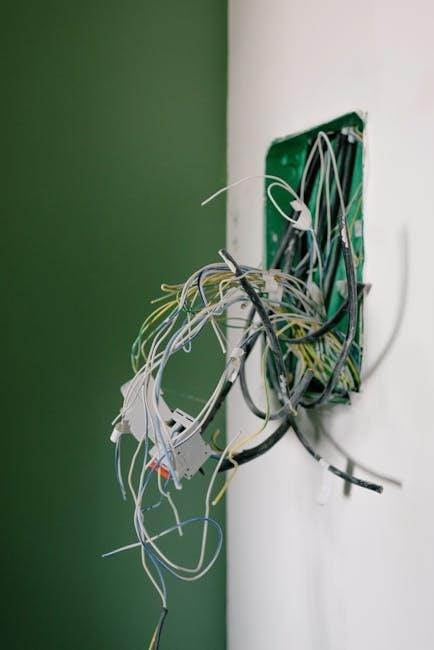
Preparation for Installation
Gather tools, hardware, and ensure wall compatibility. Check TV dimensions, weight, and VESA standards. Verify all parts are included and ready for mounting.
2.1 Tools and Hardware Required
A stud finder, drill, screws, level, and wrench are essential. Use M6 or M8 screws based on TV compatibility. Ensure wall anchors and spacers are included for stability. Always refer to the installation manual for specific hardware requirements and torque specifications to avoid damage or instability. Proper tools ensure a secure and level installation, preventing potential hazards.
2.2 Understanding Wall Types (Wood, Brick, Plaster, etc.)
Understanding wall types is crucial for secure TV mount installation. Wood studs require a minimum of 2×4 for stability, while brick or plaster walls need specialized anchors. Cinder block walls must have sufficient concrete thickness verified. Each type demands specific hardware to ensure stability and safety, preventing potential hazards and ensuring a reliable setup. Proper selection of hardware based on wall type is essential for a successful installation, avoiding damage or instability.
2.3 Checking TV Compatibility and VESA Standards
Ensure your TV is compatible with the wall mount by verifying VESA standards, which define the mounting hole patterns on the TV’s back. Check the TV’s manual for VESA measurements, typically ranging from 75x75mm to 400x400mm. Additionally, confirm the mount supports your TV’s weight and size. If necessary, use adapters or spacers to address any compatibility issues, ensuring a secure and proper fit for your TV on the wall mount.

Wall Plate Installation
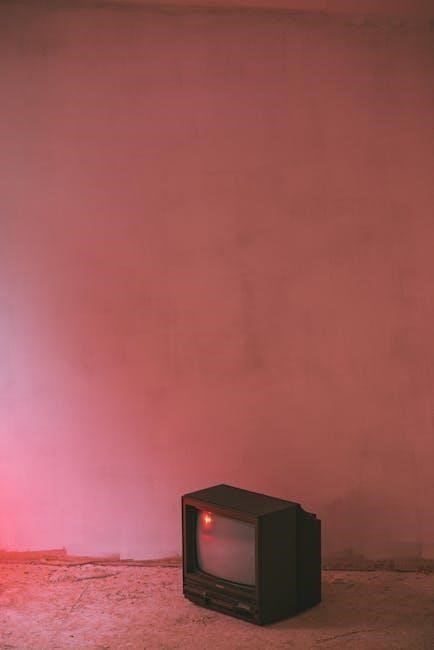
Secure the wall plate to the wall using appropriate hardware, ensuring it is level and aligned properly for stable TV mounting.
3.1 Locating Wall Studs for Secure Mounting
Locating wall studs is crucial for secure mounting. Use a stud finder or knock gently on the wall to identify studs. Typically, studs are 16 inches apart. For heavy TVs, ensure the wall plate is anchored to multiple studs. Mark the stud locations accurately before drilling to avoid damage. Proper alignment ensures stability and prevents the mount from shifting over time.
3.2 Drilling and Mounting the Wall Plate
Drill pilot holes into the marked stud locations using a drill bit slightly smaller than the wall plate screws. Insert wall anchors if studs aren’t available. Mount the wall plate securely, ensuring it’s level. Tighten screws firmly but avoid over-tightening. For non-stud walls, use specialized hardware like molly bolts or toggle anchors. Double-check the plate’s stability before proceeding. Always follow the manufacturer’s instructions for specific mounting hardware requirements.
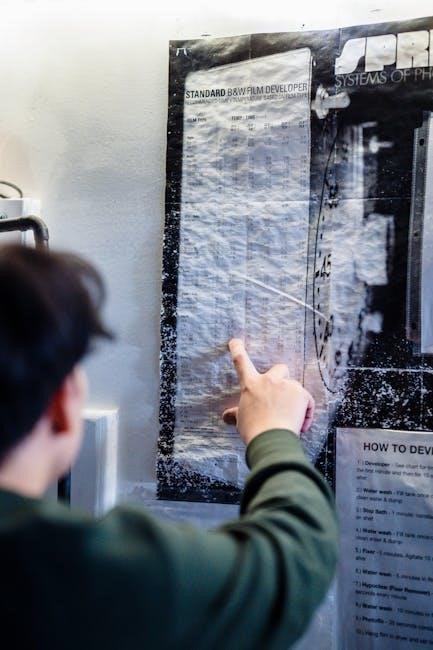
3.3 Leveling the Wall Plate
Place a spirit level on the wall plate to ensure it’s perfectly horizontal and vertical. If uneven, loosen the mounting screws slightly, adjust the plate, and retighten. Double-check the level to confirm accuracy; For optimal stability, ensure the plate is flush against the wall. Once level, tighten all screws firmly to secure the plate in place. Proper leveling prevents the TV from tilting and ensures a professional finish.

Attaching the TV to the Mount
Lift the TV carefully and hook it onto the wall mount. Ensure the TV is securely fastened using the provided screws for stability and proper alignment.
4.1 Determining Screw Diameter (M6 or M8)
Check the TV’s mounting holes to determine the correct screw diameter (M6 or M8). Ensure compatibility with VESA standards and the wall mount hardware. For flat-back TVs, no spacers are needed, while curved or thicker TVs may require specific adapters. Always refer to the installation manual for precise measurements and compatibility. Using the wrong screw size can compromise stability and safety.
4.2 Hooking the TV onto the Wall Mount
Lift the TV carefully and align its mounting hooks with the wall mount brackets. Gently lower the TV onto the mount, ensuring the hooks click securely into place. Double-check alignment to avoid uneven hanging. Always have a second person assist for safety. Once hooked, ensure the TV is stable before releasing it. Proper alignment ensures a secure fit and prevents damage to the TV or mount. Follow the manufacturer’s instructions for specific models. Ensure the mount is sturdy and level for optimal support. Avoid forcing the TV onto the mount, as this may damage the hardware. If unsure, consult the installation manual or a professional. Proper installation ensures safety and prevents potential hazards. Always verify the TV’s weight limit matches the mount’s capacity. A secure connection is crucial for stability and longevity; Regular inspections are recommended to maintain safety standards. Follow all safety precautions during this step to avoid accidents. Ensure the TV is centered and evenly balanced on the mount. Use a level tool to confirm proper alignment. Tighten all screws firmly after securing the TV. Be cautious not to overtighten, as this may damage the mount or TV. Always refer to the provided instructions for specific torque requirements. Avoid overloading the mount beyond its specified weight capacity. If unsure about any step, consider consulting a professional installer. Proper installation ensures a safe and enjoyable viewing experience. Always prioritize safety and stability when mounting your TV. Use a soft cloth to protect the TV’s screen during handling. Ensure all cables are securely connected and routed properly. Follow all local safety guidelines and regulations. A well-installed mount enhances the overall viewing experience. Regular maintenance is essential to ensure long-term stability. Inspect the mount periodically for any signs of wear or loose screws. Address any issues promptly to maintain safety. Keep the installation manual handy for future reference. Proper care ensures the mount remains secure and functional. Always use genuine or recommended hardware for replacements. Avoid using damaged or corroded screws, as they may compromise stability. Ensure all parts are tightened evenly to distribute weight properly. Proper installation is key to enjoying your TV without concerns. Always follow the manufacturer’s guidelines for optimal results. Keep children and pets away during the installation process. Use protective gear if necessary. Ensure the mounting area is clear of obstacles. A clean workspace ensures a smooth installation process. Always test the mount’s stability before finalizing the installation. Adjust as needed to achieve perfect alignment. Ensure the TV is at a comfortable viewing height. Avoid placing the TV in direct sunlight or extreme temperatures. Proper positioning enhances viewing quality and longevity. Always unplug the TV before starting the installation; Ensure all power cables are safely managed. Use cable ties or organizers to keep wires tidy. A neat setup reduces the risk of tripping hazards. Always follow safety guidelines when handling electrical components. Ensure the wall can support the combined weight of the TV and mount. Consult a professional if unsure about wall strength. Use a stud finder to locate the wall’s structural supports. Secure the mount to studs for maximum stability. Avoid mounting on weak or damaged walls. Ensure the mount is compatible with the wall type (wood, brick, etc.). Use appropriate hardware for different wall types. Follow the manufacturer’s recommendations for wall anchors or brackets. Proper hardware ensures a secure and stable installation. Always double-check the mount’s compatibility with your TV’s size and weight. Refer to the VESA standards for mounting patterns. Use a level tool to ensure the mount is perfectly horizontal. Adjust the mount as needed to achieve proper alignment. Ensure the TV is securely fastened to prevent any movement. Regularly inspect the mount for signs of wear or damage. Replace any damaged parts immediately to maintain safety. Always follow the manufacturer’s warranty and maintenance guidelines. Proper care ensures the mount remains durable and reliable. Keep all installation tools and hardware in a safe place for future adjustments. Always refer to the installation manual for troubleshooting common issues. Address any problems promptly to prevent further damage. Ensure the TV is properly grounded to avoid electrical hazards. Follow all local electrical safety standards. Use surge protectors to safeguard against power surges. Ensure all connections are secure and tightly fitted. Avoid overloading power outlets or extension cords. Keep the installation area well-ventilated to prevent overheating. Ensure the TV is at a safe distance from flammable materials. Always follow fire safety guidelines during installation. Keep emergency contact information handy in case of an accident. Ensure the installation area is well-lit to avoid tripping hazards. Use a ladder or step stool safely, if necessary. Always maintain three points of contact when climbing. Ensure the ladder is stable and secure before use. Follow all ladder safety guidelines to prevent falls. Keep the workspace clean and organized to avoid accidents. Ensure all tools are stored safely after use. Always unplug tools when not in use. Keep children and pets away from the installation area. Use protective eyewear if necessary. Ensure the TV is handled with care to avoid screen damage. Use a soft cloth to protect the screen during installation. Avoid touching the screen to prevent fingerprints and smudges. Use gloves when handling the TV to maintain cleanliness. Ensure the TV is clean and dry before mounting. Avoid installing the TV in areas with high humidity or moisture. Use a dehumidifier if necessary to maintain a dry environment. Ensure the mount is rust-resistant if installed in a damp area. Regularly inspect the mount for signs of corrosion. Replace any rusted parts immediately to maintain stability. Always follow the manufacturer’s recommendations for rust prevention. Use protective coatings or sprays if necessary. Ensure the mount remains durable in various environmental conditions. Regular maintenance ensures the mount stays secure and functional. Keep the installation manual handy for future reference. Always refer to the manufacturer’s guidelines for specific care instructions; Proper maintenance ensures the mount remains safe and reliable. Address any issues promptly to prevent further damage. Ensure the TV is securely fastened to the mount at all times. Regularly check the tightness of all screws and bolts. Use a torque wrench for precise tightening, if recommended. Avoid overtightening, as this may damage the mount or TV. If unsure about torque specifications, consult the installation manual. Always use genuine or recommended replacement parts. Avoid using damaged or incompatible hardware. Ensure all parts are properly aligned before tightening. Use a spirit level to confirm the mount’s alignment. Adjust the mount as needed to achieve perfect horizontal and vertical alignment. Ensure the TV is evenly balanced on the mount. Use a measuring tape to confirm proper spacing and alignment. Follow the manufacturer’s instructions for specific adjustment procedures. Always test the mount’s stability before finalizing the installation. Gently rock the TV back and forth to ensure it is secure. Check for any wobbling or movement. Address any instability issues immediately. Ensure the mount is firmly attached to the wall. Use a stud finder to locate the wall’s structural supports. Secure the mount to studs for maximum stability. Avoid mounting on weak or damaged walls. Use appropriate hardware for different wall types. Follow the manufacturer’s recommendations for wall anchors or brackets. Proper hardware ensures a secure and stable installation. Always double-check the mount’s compatibility with your TV’s size and weight. Refer to the VESA standards for mounting patterns. Use a level tool to ensure the mount is perfectly horizontal. Adjust the mount as needed to achieve proper alignment. Ensure the TV is securely fastened to prevent any movement. Regularly inspect the mount for signs of wear or damage. Replace any damaged parts immediately to maintain safety. Always follow the manufacturer’s warranty and maintenance guidelines. Proper care ensures the mount remains durable and reliable. Keep all installation tools and hardware in a safe place for future adjustments. Always refer to the installation manual for troubleshooting common issues. Address any problems promptly to prevent further damage. Ensure the TV is properly grounded to avoid electrical hazards. Follow all local electrical safety standards. Use surge protectors to safeguard against power surges. Ensure all connections are secure and tightly fitted. Avoid overloading power outlets or extension cords. Keep the installation area well-ventilated to prevent overheating. Ensure the TV is at a safe distance from flammable materials. Always follow fire safety guidelines during installation. Keep emergency contact information handy in case of an accident. Ensure the installation area is well-lit to avoid tripping hazards. Use a ladder or step stool safely, if necessary. Always maintain three points of contact when climbing. Ensure the ladder is stable and secure before use. Follow all ladder safety guidelines to prevent falls. Keep the workspace clean and organized to avoid accidents. Ensure all tools are stored safely after use. Always unplug tools when not
4.3 Securing the TV with Tightening Screws
Tighten the screws gradually in a star pattern to ensure even pressure. Use the recommended screw diameter (M6 or M8) and torque specifications from the manual. Avoid overtightening, as this may damage the TV or mount. Ensure the TV is stable and weight is evenly distributed. Double-check the screws for firmness but do not over-tighten. If unsure, consult the installation guide or use a torque wrench for precise tightening. Proper securing ensures long-term stability and safety.
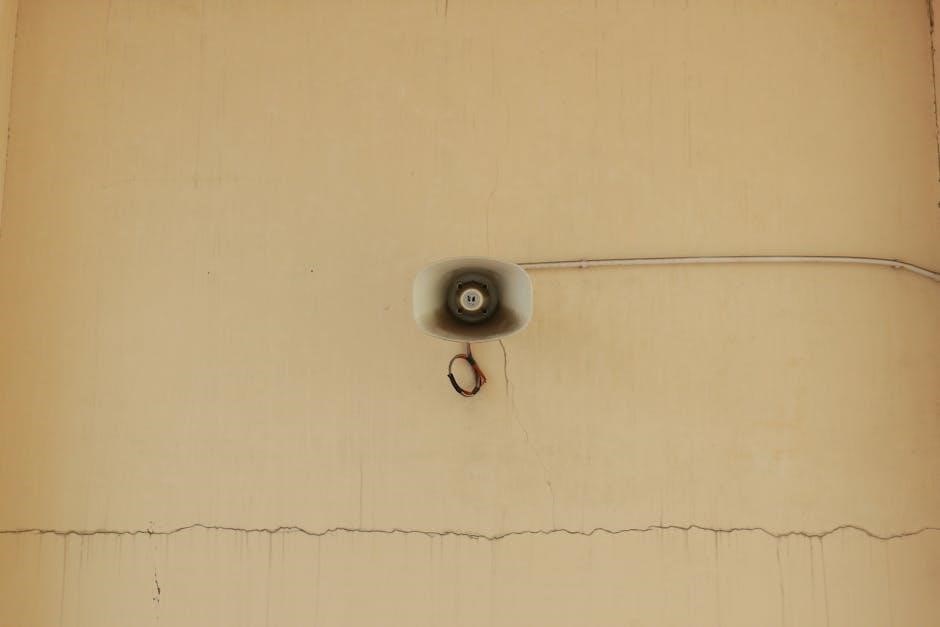
Final Adjustments and Testing
Adjust the mount for optimal viewing angles, ensuring stability and weight distribution. Perform final safety checks to confirm secure installation and proper function of all components.
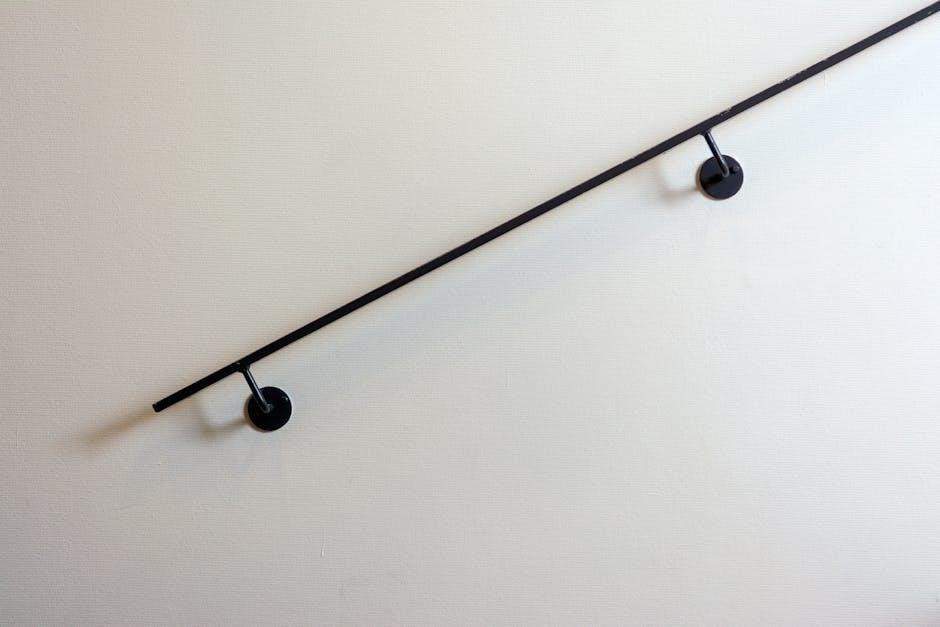
5.1 Adjusting the Mount for Optimal Viewing Angle
Use a level to ensure the mount is straight. Tilt or swivel the TV as needed for the best view. Tighten screws firmly but avoid over-tightening. Ensure the TV is securely locked into place. Adjust the mount’s height and angle to achieve a comfortable viewing position. Double-check all connections and verify the TV’s stability. Make final tweaks to alignment and spacing.
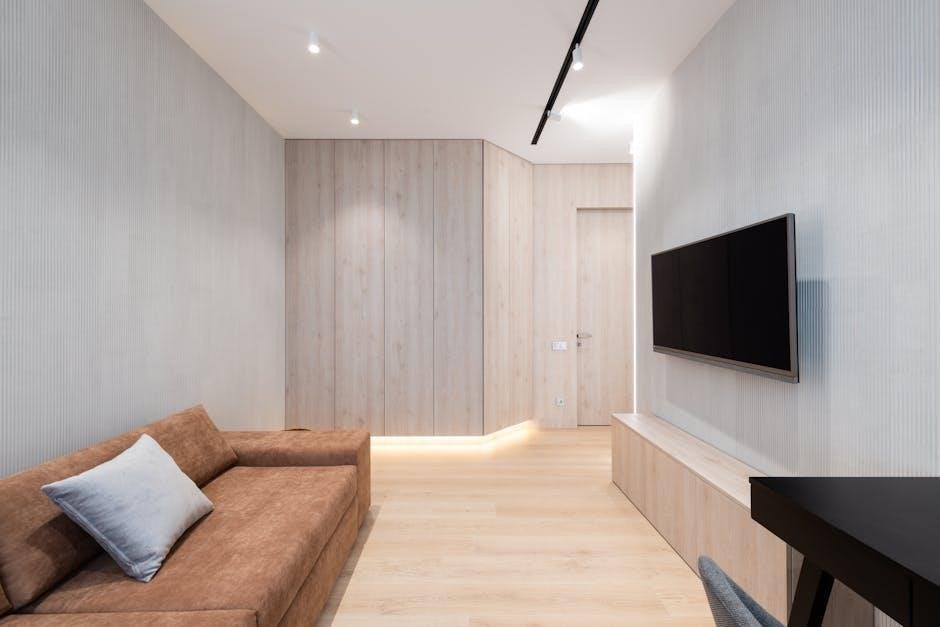
Maintenance and Care
5.2 Ensuring Stability and Weight Distribution
Ensure the mount is securely fastened to wall studs to support the TV’s weight. Use the correct screws and hardware to avoid damage. Check the weight limit of the mount to confirm it can handle your TV. Tighten all screws evenly to maintain balance. Double-check the TV’s alignment and ensure it is level. Verify the mount’s stability by gently rocking the TV. If needed, adjust the mount’s position for even weight distribution.

